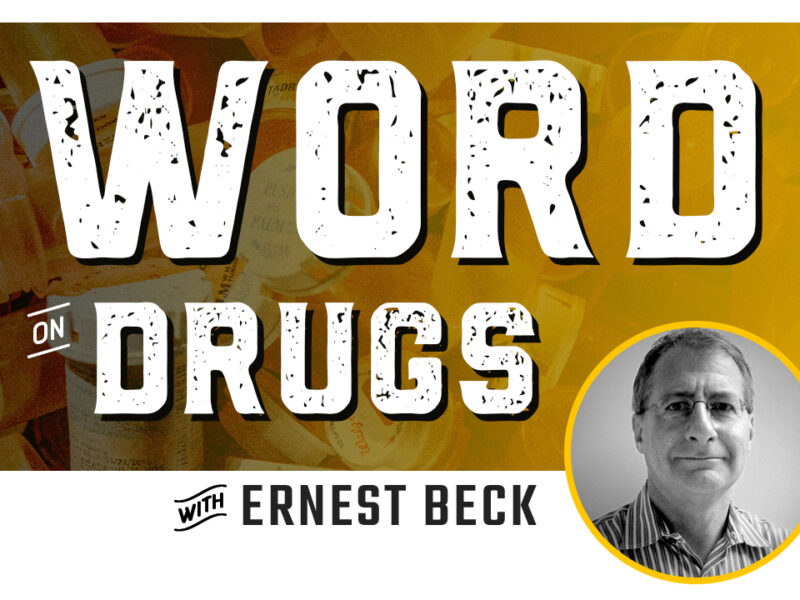THE WORD ON DRUGS: Locking Up Substance Users Won’t End Drug Addiction or Overdose Deaths
- Published In: Other News & Features
- Last Updated: May 18, 2023

By Ernest Beck
Special to the Wyoming Truth
While more Americans are dying of drug overdose than ever before — with an estimated 108,000 fatalities over the past 12 months alone — there is another epidemic of addiction and death taking place largely out of sight in our prisons and jails. An estimated two-thirds of those entering such facilities have an active substance-use disorder and little chance of receiving effective treatment, according to the nonprofit Jail and Prison Opioid Project.
With only 630 of the roughly 5,000 prisons and jails nationwide providing medication-assisted treatment (MAT) that combines drugs to ease cravings with counseling and behavioral therapies, inmates are routinely forced into detox—a harsh experience that does not adequately address the complex causes of addiction or contribute to successful recovery.
Now the Biden administration is trying to boost funding for opioid addiction treatment for the incarcerated through a novel Medicaid program to cover health care in prisons and jails. But given the political polarization in Congress over drug policy, it is unclear if this will ever come to pass.
Meanwhile, drug overdose deaths among the more than 2 million incarcerated are rising faster than the national fatality rate. Blame for the crisis behind bars falls squarely on the misguided policy of locking up individuals for even low-level, nonviolent drug offenses and failing to treat those in facilities who are suffering.
Still, there are viable alternatives across the country, including in Wyoming, to help those struggling with substance use avoid getting stuck in the criminal justice system and provide those serving sentences with evidence-based treatment.
One strategy is to divert drug users from entering the criminal justice system —where they don’t belong in the first place — altogether. Under Wyoming’s Law Enforcement Assisted Diversion (LEAD) initiative, after law enforcement officials have determined that a crime has been committed by someone due to substance use, they can then divert that person to community-based care for treatment and other supportive services rather than sending them to jail.
Drug courts are another approach. Here, both adult and juvenile nonviolent offenders appear before a judge and are given the stark choice between court-supervised drug treatment and prison. The first option is hardly the free pass some might assume it to be, as such treatment involves an intensive medication-assisted treatment program, strict monitoring, mandatory drug tests, job training and sanctions if any of the terms of the deal are violated.
Today, over 4,000 drug courts operate in all 50 states, serving about 150,000 patients annually and totaling nearly 1.5 million since their inception decades ago. While some critics claim drug courts force people into treatment against their will, the system has a good track record of reducing recidivism — by up to 58 percent — based on the premise that avoiding jail is enough of an incentive and motivation to get clean.
Kurt A. Zunker, the director of the Laramie County Treatment Court Programs —one of 20 such drug courts across the state — agrees. He estimates 75% of those who go through the program he runs “never get re-arrested for anything,” an enviable success rate considering the difficulties addicts have staying in rehab. About 25 people are currently in the Laramie program. Most of these cases are for felony possession of heroin and methamphetamines, and increasingly for fentanyl, the powerful synthetic opioid that is fueling record overdose deaths in Wyoming and nationwide.
Accepting treatment in place of incarceration isn’t always an easy decision. “Most people are reluctant and want to take the easiest path, which requires encouragement and some coercion to get them to choose treatment,” Zunker explained, adding that there is still considerable stigma surrounding drug use. One tactic he uses is to urge them to “just give us 30 days to see what happens.” If they get over this initial hump, there’s a good chance they will stay in the program, which is currently designed for a one-year duration and run by local treatment providers.
Nationwide, help is slowly becoming more available for those in prison. Some states are running remarkably effective pilot programs by offering medication-assisted treatment. For instance, California was able to reduce its overdose death rate by nearly 60% in what was the largest initiative of its kind in the U.S. for addicted prisoners.
In Wyoming, substance use disorder screening shows that roughly 70% of the inmate population requires formal assessment and treatment, according to the Wyoming Department of Corrections. One facility provides treatment for 72 male inmates modeled after therapeutic communities that take a holistic approach. Another offers a gender-specific treatment unit for 32 women, while a re-entry center helps those being released adapt and reintegrate into society.
Public health experts say the re-entry programs are critical, as the newly released are the most vulnerable in their post-incarceration period and can easily relapse into drug use and overdose.
Despite the success of drug court programs, Zunker said he has to scramble for more funding, resources and trained personnel to enable the court program to handle growing demand. “It boggles the mind that I’m still trying to sell this program and convince people how valuable we are, when it is so obviously needed and helping people and communities,” he said. Zunker fears that funding is always on the chopping block, even at a time when the addiction and overdose crisis is raging in the state.
Over the past three years, four drug court participants in Laramie have died of an overdose, as setbacks always occur on the long and difficult journey to a drug-free life. But what is clear is that locking up people with addiction is always a losing strategy. It was true during the failed War on Drugs and remains true today. We need a new national mindset concerning drugs and the incarcerated—one in which there is a commitment to treat people humanely and not let them succumb to deaths of despair.
After over 20 years running drug courts and treatment programs in Wyoming, Zunker believes that “we shouldn’t be housing people in prison and jails just because we’re mad at them for committing crimes due to substance use. If we took much of the money for prisons and gave it to treatment providers, we would see a lot more positive changes in our communities.”
Ernest Beck writes about drug policy. He is the former communications lead for the Rosenthal Center for Addiction Studies in New York.













